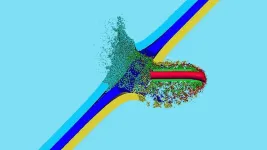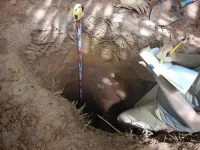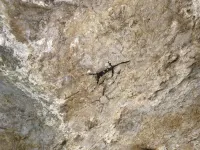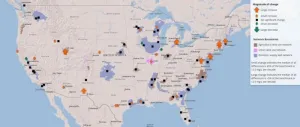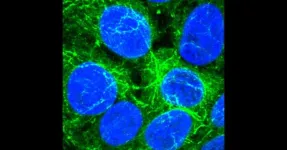(Press-News.org) In 2020, the Pantanal, the largest tropical freshwater wetland in the world and a biodiversity hotspot, was swept by high-intensity fires that destroyed native vegetation in an area totaling 44,998 square kilometers (km²), or about 30% of the Brazilian portion of the biome, which spans some 150,000 km². The estimate is presented in an article published in the science journal Fire.
The area destroyed by that year’s disastrous fires was far larger than had been thought, according to the article. Previous estimates ranged from 14,307 km² to 36,017 km². Led by scientists at the National Space Research Institute (INPE) in Brazil, the study included construction of a model based on satellite images from the European Space Agency’s SENTINEL-2 satellite, which was shown to estimate regional-scale burned areas with significantly greater precision and accuracy than other satellite-based models for the Pantanal.
The approach used in the study achieved 96% accuracy, and the results “will help to improve estimates of trace gases and aerosols associated with biomass burning”, the authors note, adding that “global biomass burning inventories are widely known for having biases at a regional scale”.
The findings highlight the need for approaches that better assess the influence of fire on ecosystems and biodiversity in regions critically sensitive to climate change, such as the Pantanal. Their importance is all the greater in light of the strength of this year’s El Niño, which could make the northern portion of the Pantanal and adjacent areas in the Upper Paraguay Basin drier and more susceptible to fire.
“The results of the study don’t show one model or product to be better than another. Every method has its own strengths and limitations. Estimates tend to vary significantly as a result. However, the images furnished by the MSI [Multispectral Instrument] on board SENTINEL-2 have two positive points: spatial resolution is 20 meters, providing much better detail of burned areas; and temporal resolution, very important to this type of study, is 5 days, compared with a revisit frequency of up to 16 days for the Landsats,” said forest engineer Andeise Cerqueira Dutra, penultimate author of the article and a PhD candidate at INPE’s Earth Observation and Geoinformatics Division (DIOTG), with Yosio Edemir Shimabukuro as thesis advisor.
Shimabukoro is the penultimate author of the article. Dutra, the first author, is supported by FAPESP via two projects (22/01746-5 and 23/02386-5). The last author is Guilherme Augusto Verola Mataveli, also a researcher at DIOTG-INPE.
For Mataveli, it is important to refine this type of analysis and obtain regional-scale estimates in order not only to estimate burned areas more accurately but also to calculate greenhouse gas emissions, which directly affect climate change.
“The 2020 Pantanal fire crisis was caused by an extreme drought. Severe drought will tend to be increasingly frequent there and in other parts of Brazil. Knowing more about the impact of these extreme weather events on the biome and its biodiversity will be more and more important to decisions regarding fire management and fire mitigation programs,” said Mataveli, whose research is also supported by FAPESP (16/02018-2, 19/25701-8, 23/03206-0 and 20/15230-5), partly via the Research Program on Global Climate Change (RPGCC).
“Finding ways to improve these products and generate more accurate data is very important for society. An example is the pilot project launched this year in the Pantanal, also using remote sensing data to identify areas affected by fire and estimate the accumulation of combustible matter. Managers of environmental agencies and firefighters can use these findings to manage fire in an integrated manner, defining priority areas and actions to combat or control fires,” Dutra said.
Consequences
The Pantanal is normally under water in the rainy season, which extends roughly between October and May, and is modulated by the South American Monsoon System (SAMS). The dry season usually begins in June or July. Fires in the region tend to peak in September. However, the pattern changed in 2019, which saw the onset of a prolonged drought that worsened in 2020, when annual precipitation in the Brazilian portion of the Pantanal was the lowest since the 1980s and 26% lower than the 1982–2020 average. As a result, the water surface area shrank 34% compared with the average, the aggregate burned area was 200% more than the long-term average, and 35% burned for the first time on record.
The cost of restoration was estimated at USD 123 million. Researchers estimated that the 2020 wildfires killed some 16 million small animals (under 2 kg) and 944,000 larger animals (read more at: revistapesquisa.fapesp.br/en/pantanal-wildfires-killed-17-million-animals).
The Jaguar (Panthera onca), the largest feline species in the Americas, was especially hard hit. The fires destroyed 45% of the estimated population of P. onca, or some 450 individuals (87% in Brazil), burning 79% of its home range area and 54% of protected areas within that range. Until then, the Pantanal was home to the second-largest population of jaguars in the world.
Another consequence was a rise in the number of people hospitalized for treatment of respiratory problems in the states of Mato Grosso and Mato Grosso do Sul, as shown by a study conducted by Oswaldo Cruz Foundation (Fiocruz), an arm of Brazil’s Health Ministry.
Methodology
The researchers used satellite images from SENTINEL-2 to estimate burned areas in the Brazilian part of the Pantanal in 2020 and compared these with estimates based on MODIS (the Moderate Resolution Imaging Spectroradiometer sensors aboard NASA’s Terra and Aqua satellites) and Landsat imaging. The former (MCD64A1 and Fire_cci) gave estimates of 35,837 km² and 36,017 km² respectively, while the latter (MapBiomas Fogo and GABAM) gave estimates of 23,372 km² and 14,307 km².
The spatial distribution patterns in these maps were visually similar, but the estimates based on SENTINEL-2 imaging detected a larger number of smaller fires, especially in the eastern Pantanal. “The model we developed is available to anyone interested, as is the data collected in the validation exercise. We believe they can help researchers engaged in future projects,” Mataveli said.
“Drought is set to be increasingly frequent, and fire episodes therefore will tend to be more frequent as well, so we expect more collaborative research and a growing supply of data,” Dutra said. “We also expect more field data to be accessible, especially for scientists who work with remote sensing to produce more accurate output.”
Between January 1 and August 23, 2023, 381 fires were detected in the Pantanal, according to data from INPE. In the same period of 2020, there were 8,127, the highest number since 1998 for the biome. Forest fires have intensified this year in the context of heatwaves in Europe and North America, leaving many deaths and ruined neighborhoods in their wake.
About São Paulo Research Foundation (FAPESP)
The São Paulo Research Foundation (FAPESP) is a public institution with the mission of supporting scientific research in all fields of knowledge by awarding scholarships, fellowships and grants to investigators linked with higher education and research institutions in the State of São Paulo, Brazil. FAPESP is aware that the very best research can only be done by working with the best researchers internationally. Therefore, it has established partnerships with funding agencies, higher education, private companies, and research organizations in other countries known for the quality of their research and has been encouraging scientists funded by its grants to further develop their international collaboration. You can learn more about FAPESP at www.fapesp.br/en and visit FAPESP news agency at www.agencia.fapesp.br/en to keep updated with the latest scientific breakthroughs FAPESP helps achieve through its many programs, awards and research centers. You may also subscribe to FAPESP news agency at http://agencia.fapesp.br/subscribe.
END
In 2020, 30% of the Pantanal was burned to cinders by wildfires
This is one of the findings of a study led by Brazilian scientists and reported in the science journal Fire. The researchers built a model based on images from the SENTINEL-2 satellite and were able to detect burned areas much more accurately
2023-10-17
ELSE PRESS RELEASES FROM THIS DATE:
SwRI will advance impact modeling software for U.S. Army Corps of Engineers
2023-10-17
SAN ANTONIO — October 17, 2023 —Southwest Research Institute (SwRI) will continue advancing the Elastic Plastic Impact Computations (EPIC) dynamic finite-element code as part of an Other Transaction Prototype Agreement with the U.S Army Corps of Engineers. The first year’s funding of $500,000 has been awarded, with optional additional funding across the next three years totaling $3.5 million.
“EPIC uses finite element and particle methods to simulate complex impact and explosion scenarios,” said SwRI Staff Engineer Dr. Stephen Beissel, who leads the EPIC project and has been involved in EPIC’s development since the mid-1990s. ...
The earthworm effect: unraveling soil weathering dynamics
2023-10-17
17 October 2023
The Geological Society of America
Release No. 23-42
Contact: Justin Samuel
+1-303-357-1026
jsamuel@geosociety.org
For Immediate Release
Contributed by Sarah Derouin
Pittsburgh, Pa., USA: Earthworms, the hardworking invertebrates that grace the upper layers of soil, have long been considered helpful in our home gardens. Earthworms are prolific munchers, grinding up organic material and sediment grains that make up soils. Although they are very different animals, worms, like many poultry, have gizzards. “Worms will ingest some larger soil grains, and then they use the strongest and largest of those grains, retaining them in their gizzard,” ...
New dating of cave art reveals history of Puerto Rican people
2023-10-17
17 October 2023
The Geological Society of America
Release No. 23-40
Contact: Justin Samuel
+1-303-357-1026
jsamuel@geosociety.org
For Immediate Release
Leer en español.
Contributed by Sarah Derouin
Pittsburgh, Pa., USA: In the karstic caves of Puerto Rico, cave art paints the rock walls. Previous research has assigned ages to this art based on the ages of nearby archaeological artifacts within the caves, but these ages are relative and may not reflect the true timing of the art creation.
Now, a new study to be presented Wednesday at the Geological Society of America’s GSA Connects 2023 meeting shows that researchers have refined the age of this rupestrian ...
U.S. groundwater is getting saltier—what that means for infrastructure, ecosystems, and human health
2023-10-17
17 October 2023
The Geological Society of America
Release No. 23-41
Contact: Justin Samuel
+1-303-357-1026
jsamuel@geosociety.org
For Immediate Release
Contributed by Sarah Derouin
Pittsburgh, Pa., USA: Scientists from the U.S. Geological Survey (USGS) have been monitoring groundwater quality in wells across the country for more than three decades, looking for harmful chemicals or residual substances that may cause harm to ecosystems or humans. In all, they have measured up to 500 chemical constituents, including major ions, metals, pesticides, volatile organic compounds, fertilizers, and radionuclides.
Of ...
Pathogen that plagues food processing plants eradicated by blue light
2023-10-17
Washington, D.C. – Blue light kills both dried cells and biofilms of the pathogen Listeria monocytogenes, a frequent contaminant of food processing facilities. Demise of L. monocytogenes occurred quickest when cells or biofilms were placed on polystyrene, a widely used, transparent form of plastic. The research is published in Applied and Environmental Microbiology, a journal of the American Society for Microbiology.
“These results contribute to advancing our understanding of the potential of blue light to treat inert surfaces contaminated with L. monocytogenes,” said corresponding author ...
Public health interventions prevented transmission within BU most SARS-CoV-2 cases
2023-10-17
(Boston)— SARS-CoV-2, the causative agent of COVID-19, began impacting the U.S. in March 2020 with many schools and universities shifting to remote education by early April 2020 in response to the public health emergency. Despite public health interventions (increased ventilation, masking policies, surveillance testing, contact tracing of confirmed cases and quarantine procedures for infected students, faculty and staff) there were still concerns that institutes of higher education would be a hotbed of transmission, including transmission from students into surrounding communities.
But, were these fears warranted?
A ...
CastleVax Inc. receives BARDA project NextGen award valued at up to $338 million to advance intranasal NDV-based COVID-19 booster vaccine into phase 2b clinical efficacy testing
2023-10-17
CastleVax, a clinical stage vaccine platform company, has received a Project NexGen award valued at up to $338 million from the Biomedical Advanced Research and Development Authority (BARDA), part of the Administration for Strategic Preparedness and Response (ASPR) in the U.S. Department of Health and Human Services (HHS), to support the development of a next-generation, booster vaccine to protect against COVID-19 for years to come. The initial phase of the award provides approximately $8.5 million to plan a Phase 2b clinical trial that would compare CastleVax’s vaccine to currently ...
New cancer therapy target stops tumor cells from sharing resources
2023-10-17
Researchers at University of California San Diego have discovered a process in which liver cells share molecules via vesicle exchange in order to multiply under conditions that would ordinarily suppress cell proliferation. They also found evidence that this process occurs in various types of cancer cells, paving the way for a new approach to tackling treatment resistance in cancer. The findings were published on October 17, 2023 in eLife.
“Understanding cell proliferation is a fundamental issue in both cancer research and biomedical science as a whole,” said Gen-Sheng Feng, PhD, a professor of pathology at UC San Diego School of Medicine and of molecular biology ...
International team reveals source of largest ever Mars quake
2023-10-17
A global team of scientists have announced the results of an unprecedented collaboration to search for the source of the largest ever seismic event recorded on Mars. The study, led by the University of Oxford, rules out a meteorite impact, suggesting instead that the quake was the result of enormous tectonic forces within Mars’ crust.
The quake, which had a magnitude of 4.7 and caused vibrations to reverberate through the planet for at least six hours, was recorded by NASA’s InSight lander on May 4 2022. ...
The dark side of the American lawn
2023-10-17
The American residential lawn is, for many, an iconic landscape and about half of homeowners in the US use fertilizer to keep their yards green and lush. Some proportion of the nitrogen in this fertilizer enters the broader environment, with negative consequences including algal blooms and deoxygenated waters. Peter Groffman and colleagues studied residential landscapes in the Baltimore, Maryland metropolitan area, which drains to the Chesapeake Bay, seeking to identify locations (hotspots) or times (hot moments) with disproportionately high rates of nitrogen export. The authors went to lawns in exurban, ...
LAST 30 PRESS RELEASES:
Layered hydrogen silicane for safe, lightweight, and energy-efficient hydrogen carrier
Observing positronium beam as a quantum matter wave for the first time
IEEE study investigates the effects of pointing error on quantum key distribution systems
Analyzing submerged fault structures to predict future earthquakes in Türkiye
Quantum ‘alchemy’ made feasible with excitons
‘Revoice’ device gives stroke patients their voice back
USF-led study: AI helps reveal global surge in floating algae
New method predicts asthma attacks up to five years in advance
Researchers publish first ever structural engineering manual for bamboo
National poll: Less than half of parents say swearing is never OK for kids
Decades of suffering: Long-term mental health outcomes of Kurdish chemical gas attacks
Interactional dynamics of self-assessment and advice in peer reflection on microteaching
When aging affects the young: Revealing the weight of caregiving on teenagers
Can Canada’s health systems handle increased demand during FIFA World Cup?
Autistic and non-autistic faces may “speak a different language” when expressing emotion
No clear evidence that cannabis-based medicines relieve chronic nerve pain
Pioneering second-order nonlinear vibrational nanoscopy for interfacial molecular systems beyond the diffraction limit
Bottleneck in hydrogen distribution jeopardises billions in clean energy
Lung cancer death rates among women in Europe are finally levelling off
Scientists trace microplastics in fertilizer from fields to the beach
The Lancet Obstetrics, Gynecology, & Women’s Health: Taking paracetamol during pregnancy does not increase risk of autism, ADHD or intellectual disabilities, confirms new gold-standard evidence review
Taking paracetamol during pregnancy does not increase risk of autism, ADHD or intellectual disabilities
Harm reduction vending machines in New York State expand access to overdose treatment and drug test strips, UB studies confirm
University of Phoenix releases white paper on Credit for Prior Learning as a catalyst for internal mobility and retention
Canada losing track of salmon health as climate and industrial threats mount
Molecular sieve-confined Pt-FeOx catalysts achieve highly efficient reversible hydrogen cycle of methylcyclohexane-toluene
Investment in farm productivity tools key to reducing greenhouse gas
New review highlights electrochemical pathways to recover uranium from wastewater and seawater
Hidden pollutants in shale gas development raise environmental concerns, new review finds
Discarded cigarette butts transformed into high performance energy storage materials
[Press-News.org] In 2020, 30% of the Pantanal was burned to cinders by wildfiresThis is one of the findings of a study led by Brazilian scientists and reported in the science journal Fire. The researchers built a model based on images from the SENTINEL-2 satellite and were able to detect burned areas much more accurately
